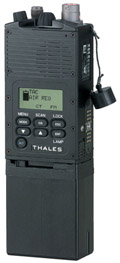
11/20/2006 - WASHINGTON (AFPN) -- The Air Force is about to enter a new era in communications technology. Officials at the Electronic Systems Center at Hanscom Air Force Base, Mass., have signed a $7.8M contract with Thales Communications, Incorporated, for the delivery of the first Joint Tactical Radio System radios to the Air Force.
More than 1200 JTRS-enhanced multiband inter/intra team radios, known as JEM radios, will be delivered to civil engineer explosive ordnance disposal units, security forces and air support operations squadrons across the Air Force. The radios will provide communications for convoy operations and enhance interoperability with the Army.
JTRS is a Defense Department-mandated, software-defined radio development program. A key element of the JTRS program is the network-centric capability it will provide to the warfighter.
JTRS eventually will bring internet-like capabilities to the battlefield, enabling the transfer of voice, data and video between Air Force and joint users alike.
Another significant feature is the ability of JTRS radios to "port" and operate various waveforms. Porting refers to loading of a software application that emulates the capabilities of legacy radios in use in the field today.
In short, if a user needs to talk to an Air Force aircraft using a specific waveform, that waveform is loaded into the radio. If later, that same user needs to communicate with an Army convoy unit using a completely different waveform, then that waveform is loaded into the same radio.
This capability gives the warfighter interoperability in a joint environment without the need to carry and maintain numerous different types of radios.
The JEM being delivered to the Air Force, while not network capable, will provide the interoperability aspects the JTRS program is seeking to fulfill. Aside from the basic ultra high frequency and very high frequency AM voice waveforms, the JEM will work in several frequency-hopping modes, plus is capable of porting future JTRS waveforms within its operating range. Deliveries will begin later this year.
This delivery of radios is just the first installment of a multi-year migration to JTRS. The Air Force's path to JTRS is documented in the Air Force JTRS migration plan. This document, compiled by the Air Force Command and Control Intelligence, Surveillance and Reconnaissance Center JTRS lead command office, was originally signed Dec. 29, 2003.
The JTRS lead command office has conducted numerous data calls throughout the Air Force to determine what requirements exist, validated those requirements through the major commands, and documented them in the migration plan. Version 2 of the migration plan is currently being staffed through the MAJCOMs, and is expected to be signed before the end of the year.
And from Thales:
Thales’ AN/PRC-148 JEM Becomes the First Government Approved Joint Tactical Radio System Radio in Production
CLARKSBURG, Md., November 16, 2006: Thales Communications, Inc., announces the award of a competitive contract from the U.S. Air Force Joint Tactical Radio System (JTRS) Program Office, Electronic Systems Center, Hanscom AFB, Mass., for the purchase of more than 1,200 AN/PRC-148 JEM radios. This award will equip security forces, civil engineering, and tactical air control personnel with the AN/PRC-148 JEM as well as associated ancillaries and accessories.
The AN/PRC-148 JEM--JTRS Enhanced Multiband Inter/Intra Team Radio (MBITR)--is the first JTRS radio certified for compliance with Software Communications Architecture (SCA)*. The only JTRS radio to have successfully completed Joint Interoperability Test Command testing, the AN/PRC-148 JEM has been deemed to be effective and suitable for deployment to the field. The needs of the warfighter are now met with a low-risk radio that not only incorporates JTRS SCA architecture but has also been user-tested and qualified in operational field conditions.
“The JEM provides the backbone for a system communications solution that will allow the Air Force to migrate toward, and stay on the forefront of, new technology,” said Ray Bruhn, manager of Air Force programs at Thales Communications. “It positions them to maximize use of their available resources, meet the mounting challenges of size-, weight-, and power-constrained battlespace environments, and maintain their technological edge.”
Based on the combat-proven MBITR and developed under a formal U.S. Government program of record, the JEM provides a seamless, cost-effective path to JTRS. The radio leverages a proven platform, and provides a JTRS solution that bridges the gap between legacy equipment and future JTRS technologies. Thales has turned the JTRS vision into reality and is providing warfighters with tomorrow’s radio today.
*SCA compliant with waivers
Editor’s Note: There are currently more than 80,000 AN/PRC-148 MBITRs fielded, and this number is continually increasing. The AN/PRC-148 MBITR is being used extensively in Operation Enduring Freedom, Operation Iraqi Freedom, and the Global War on Terrorism. The AN/PRC-148 (both MBITR and JEM configurations) is the cornerstone of a complete system solution for the warfighter which includes a Vehicle Adapter with a unique, cable-free, rapid radio dismount capability; the dual radio AN/VRC-111 Vehicle Adapter Amplifier; Base Station for fixed applications; Tactical Repeater for range extension; and compact, rugged Man Portable System for dismounted operations requiring higher power output (20 watts).